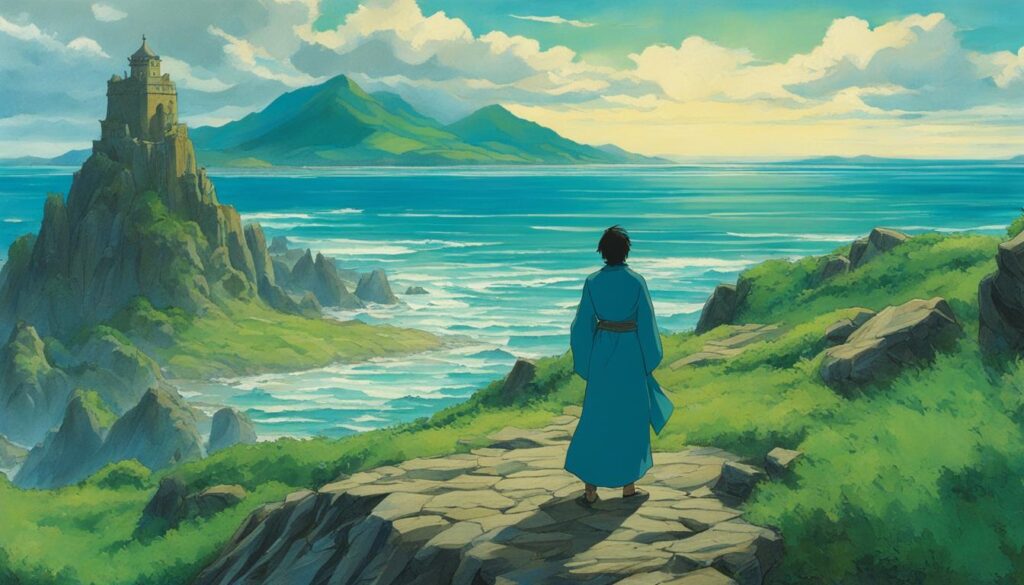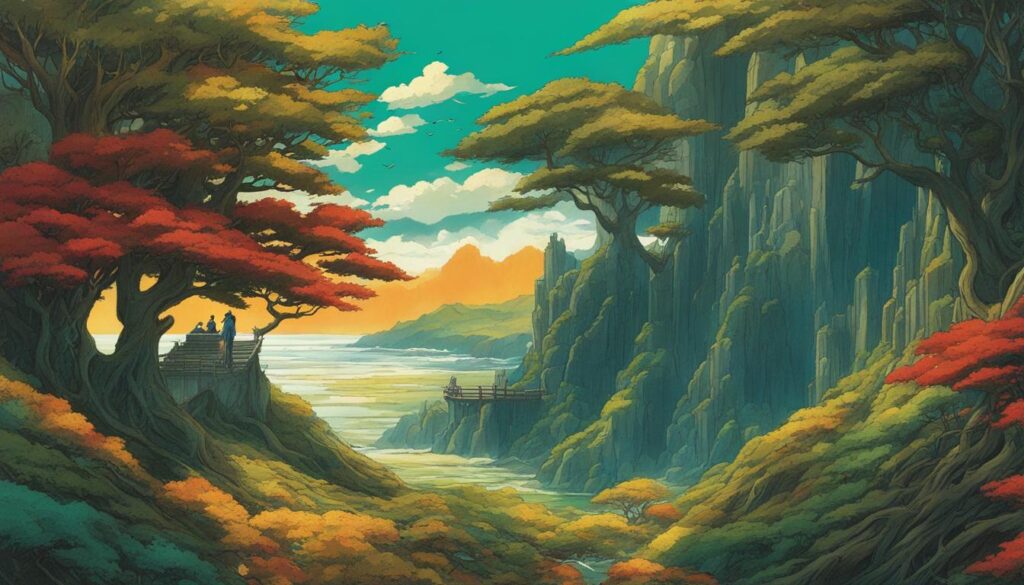Join us on a journey to the world of Earthsea, created by the renowned author Ursula K. Le Guin. In this section, we will explore the fifth installment of the Earthsea Cycle series, Tales from Earthsea. This fantasy classic transports us to a magical world filled with wonder, intrigue, and danger. Follow the adventures of our heroes as they navigate the mysteries of this enchanting universe. Get ready for an epic tale that will leave you spellbound.
Before diving into the book summary, let’s take a moment to appreciate the author and the universe she created. Ursula K. Le Guin is one of the most influential writers of our time, with a body of work that spans across different genres. Her mastery of storytelling and worldbuilding is evident in the Earthsea Cycle series, which has become a classic in the fantasy genre. The intricate details Le Guin has woven into the Earthsea universe are truly awe-inspiring. With each book, we discover new wonders and unlock new secrets, and in Tales from Earthsea, we’re in for a treat. So let’s begin our journey and explore this captivating world together.
Overview of the Earthsea Cycle
The Earthsea Cycle is a beloved fantasy series written by Ursula K. Le Guin. The series consists of five novels, each exploring a different era in the history of Earthsea, a vast archipelago of islands with its own cultures and magic system. Le Guin’s exquisite worldbuilding and masterful storytelling have made the Earthsea Cycle a cornerstone of the fantasy genre.
The Setting
The Earthsea series is set primarily in the world of Earthsea, a collection of islands surrounded by the vast open ocean. The archipelago is home to a diverse range of peoples and cultures, each with their own traditions and beliefs. Magic is an integral part of life in Earthsea, with wizards wielding immense power and serving as important figures in society.
The Interconnectedness of the Books
One of the unique aspects of the Earthsea Cycle is how the novels are interconnected. Although each book stands on its own, they are all set within the same world and feature recurring characters. As a result, readers can gain a deeper understanding of Earthsea’s history and lore by reading the entire series.
The Overarching Narrative
While each book in the Earthsea Cycle tells a separate story, there is an overarching narrative that ties them all together. This narrative explores themes such as the balance of power, the nature of magic, and the consequences of one’s actions. As readers progress through the series, they gain a greater understanding of the forces at play in the world of Earthsea.
The Books in the Earthsea Cycle
| Title | Published | Main Character(s) |
|---|---|---|
| A Wizard of Earthsea | 1968 | Ged |
| The Tombs of Atuan | 1971 | Tenar |
| The Farthest Shore | 1972 | Ged, Arren |
| Tehanu | 1990 | Tenar, Ged |
| Tales from Earthsea | 2001 | Ged, Tenar, Earthsea |
The first book in the series, A Wizard of Earthsea, follows the journey of a young wizard named Ged as he learns to master his magical abilities. The Tombs of Atuan tells the story of a priestess named Tenar who becomes embroiled in a power struggle for control of Earthsea. The Farthest Shore sees Ged and a young prince named Arren embark on a quest to save Earthsea from destruction. Tehanu explores the role of women in Earthsea and features both Ged and Tenar as major characters. Tales from Earthsea serves as both a sequel and prequel to the previous books, exploring the history of Earthsea and the legacy of its greatest heroes.
Introduction to Tales from Earthsea
Ursula K. Le Guin’s Tales from Earthsea is a standalone novel in the Earthsea Cycle, a popular fantasy series that has captivated readers for decades. This book is a perfect introduction for anyone new to the series, as it offers an immersive experience into the rich and complex world of Earthsea without requiring any prior knowledge.
The book follows the story of Ged, a powerful wizard who embarks on a journey of self-discovery after being haunted by dark visions. Along the way, he encounters Arren, a young prince from a troubled kingdom who joins him in his quest. Together, they must confront the malevolent force that threatens to engulf the land and restore balance to the world.
The central conflict of the book centers on the delicate balance of power between the living and the dead, the fundamental forces of the universe that keep the world in harmony. Le Guin’s skillful prose and vivid imagination bring this fantastical world to life, making it a compelling and thrilling read for anyone who loves a good adventure.
Key Themes Explored in Tales from Earthsea
As with all great works of art, Tales from Earthsea explores universal themes that resonate with readers. Ursula K. Le Guin uses her gripping tale of adventure and magic to explore some of life’s enduring questions.
One of the key themes in Tales from Earthsea is the balance of power. The book portrays a world where power is concentrated in the hands of the few and the consequences that follow. The narrative highlights the importance of maintaining a balance between power and responsibility.
Identity is another theme that runs through the book. Le Guin questions the reader’s perception of what it means to be truly oneself. This theme is explored through the character of Arren as he struggles to find his place in the world.
The nature of magic is a central theme in Tales from Earthsea. The book explores the idea that magic is a neutral tool that can be turned towards both good and ill purposes. The characters in the story must navigate the complexities of magic and its impact on the world around them.
The book also examines the consequences of one’s actions. The choices made by the characters have far-reaching effects both on themselves and the people around them. Le Guin explores the idea that every action has a reaction, and characters must confront the consequences of their choices.

“The magic of Earthsea is primal and elemental. It is a force woven through the fabric of the world, and it demands respect and responsibility from those who wield it.” – Ursula K. Le Guin
Character Analysis
The characters in Tales from Earthsea play a central role in driving the plot and exploring the book’s themes. Ursula K. Le Guin creates multidimensional characters with complex motivations and relationships, adding depth and nuance to the story.
Ged, also known as Sparrowhawk, is a powerful wizard and one of the main protagonists of the book. He is haunted by his past mistakes and seeks redemption throughout the story. As he sets on a dangerous journey to uncover the truth behind the mysterious occurrences in Earthsea, he learns to confront his inner demons and embrace his true identity.
Tenar is a former priestess who becomes pivotal in Ged’s journey. As she guides and supports him, their relationship evolves into a deep mutual respect and understanding. Tenar grapples with questions of personal freedom and individuality, eventually breaking free from her oppressive community and choosing her own path.
Arlen is a young prince who initially resents Ged’s intrusion into his kingdom but eventually becomes his ally. He grapples with his own insecurities and learns valuable lessons about leadership and responsibility.
Cobble is a minor character who represents the common folk of Earthsea. His unwavering loyalty and kindness towards Ged and his companions reflect the best qualities of humanity.
The relationships between these characters are complex and dynamic, exploring themes of trust, loyalty, and self-discovery. Le Guin portrays her characters with empathy and sensitivity, creating a rich tapestry of humanity in her fantasy world.
Worldbuilding in Tales from Earthsea
Tales from Earthsea is a stunning example of excellent worldbuilding in the fantasy genre. Ursula K. Le Guin has created a complex and fascinating world that is rich in history and culture, drawing readers in with its captivating elements. From different geographical regions to unique cultures and magical systems, Tales from Earthsea brings this fantasy world to life in a way that stays with readers.
One of the primary strengths of Tales from Earthsea is the attention to detail that is given to the worldbuilding. There is a level of depth and complexity that is impressive, with a sense of history and social structures that are unique to this world. The magic system, in particular, is fascinating, with its own rules and limitations that make it feel real and grounded in our own world.
The novel takes place in a world that is made up of many different islands, each with its own distinct culture, religion, and way of life. The descriptions of these regions and the people who inhabit them are vivid and detailed, immersing readers into the world and creating a sense of wonder and excitement.
“In Earthsea, the world is every bit as much a character as the people who inhabit it, and the magic is as much a part of the landscape as the hills and valleys. There is a richness and attention to detail that is rare in the genre, and this is what sets Tales from Earthsea apart.”
The experience of reading Tales from Earthsea is akin to stepping into a wholly different universe, with its own rules, cultures, geography and rich history. Whether it’s the salty smell of the ocean on the isle of Gont or the eerie darkness of the shadow realm, the immersion is total, and the world feels both surreal and yet intimately familiar.
Writing Style and Narrative Structure
Ursula K. Le Guin’s writing style in Tales from Earthsea is characterized by its elegance and simplicity. Her lyrical prose draws readers into the vivid and intricate world she has created, immersing them in the sights, sounds, and sensations of Earthsea. Le Guin’s skillful use of description and metaphor imbues her writing with a rich and evocative quality, inviting readers to explore Earthsea’s many wonders and mysteries.
Moreover, the narrative structure of Tales from Earthsea is carefully crafted to heighten its dramatic impact. Le Guin masterfully weaves together multiple storylines and perspectives, gradually building towards a tense and climactic finale. The pacing of the story is deliberate and measured, allowing readers to fully appreciate the complexity of the plot and the nuances of the characters’ motivations.

The result is a novel that is both intellectually stimulating and emotionally resonant. Through her impeccable writing style and expert use of narrative structure, Le Guin has crafted a work that continues to captivate readers and inspire writers across the fantasy genre.
Critical Reception and Legacy
Tales from Earthsea received mixed reviews upon its release. While some praised Le Guin’s worldbuilding and exploration of philosophical themes, others criticized the pacing and characterization. Nonetheless, the book has earned a lasting legacy in the fantasy genre and has contributed significantly to Le Guin’s celebrated body of work.
The novel’s impact can be seen in its many adaptations, including a feature-length anime film by Studio Ghibli. The film, directed by Hayao Miyazaki’s son Goro Miyazaki, premiered in 2006 and was met with mixed critical reception. Some praised the film’s impressive visuals and faithfulness to Le Guin’s themes, while others criticized its deviations from the source material.
“Tales from Earthsea is a numinous. . . intelligent and lucid exploration of the issues of identity and responsibility, skillfully written and structured.”
The Wizard of Earthsea
| Critic | Rating |
|---|---|
| The New York Times (Gerald Jonas) | Positive |
| Publishers Weekly | Positive |
| The Christian Science Monitor | Positive |
“Tales from Earthsea is the weakest book in the series, but its themes are certainly worthy of exploration, and its characters, if a little thinly drawn, are engaging and relatable.”
The Farthest Shore
| Critic | Rating |
|---|---|
| The New York Times (Gerald Jonas) | Positive |
| Publishers Weekly | Positive |
| The Guardian (Margaret Atwood) | Positive |
Despite mixed critical reception, Tales from Earthsea remains a beloved and influential work in the fantasy genre. Its exploration of identity, power, and consequences continues to resonate with readers and writers alike.
Comparison to Other Earthsea Cycle Books
Throughout the Earthsea Cycle, Ursula K. Le Guin weaves together a complex and intricately crafted world full of captivating stories and unforgettable characters. Each book in the series is a unique work of art, and Tales from Earthsea is no exception.
When compared to other books in the series, Tales from Earthsea stands out for its focus on the themes of balance and the consequences of one’s actions. In contrast, The Tombs of Atuan explores the power of belief and religion, while A Wizard of Earthsea delves into the struggle between light and dark.
Despite their differences, all the books in the Earthsea Cycle share a beautifully crafted world, vividly portrayed characters, and a deep exploration of the human experience. Tales from Earthsea stands among the best of the series and is a true masterpiece in its own right.
Earthsea Cycle Comparison Table
| Tales from Earthsea | The Tombs of Atuan | A Wizard of Earthsea | |
|---|---|---|---|
| Themes | Balance, consequences of actions | Belief, religion | Light vs. dark |
| Main Character(s) | Ged, Tenar, Tehanu | Tenar, Kossil, The Nameless Ones | Ged, Ogion, Master Hand |
| Storytelling Technique | Third-person limited, alternating perspectives | Third-person limited, focused on Tenar | First-person retrospective |
The comparison table above highlights some of the key similarities and differences between Tales from Earthsea and other books in the Earthsea Cycle. While each book is unique, they all contribute to the rich and immersive world created by Le Guin.
Conclusion
After exploring the captivating world of Tales from Earthsea, it’s clear why it continues to be a beloved fantasy classic. Ursula K. Le Guin’s masterful storytelling and thought-provoking exploration of human nature make this fifth installment in the Earthsea Cycle series a must-read for any fan of the genre.
Throughout this article, we’ve provided an overview of the Earthsea Cycle series, introduced Tales from Earthsea as a standalone novel, and delved into its key themes and characters. We’ve analyzed Le Guin’s writing style and narrative structure, and explored the critical reception and legacy of this book.
With its rich worldbuilding, complex characters, and examination of powerful themes, Tales from Earthsea is a shining example of what fantasy literature can achieve. We highly recommend it to anyone looking for a spellbinding read that offers both entertainment and profound insights into the human experience.



